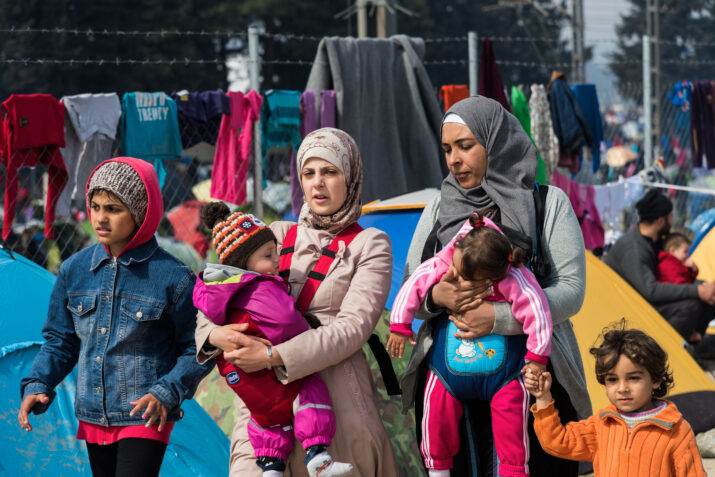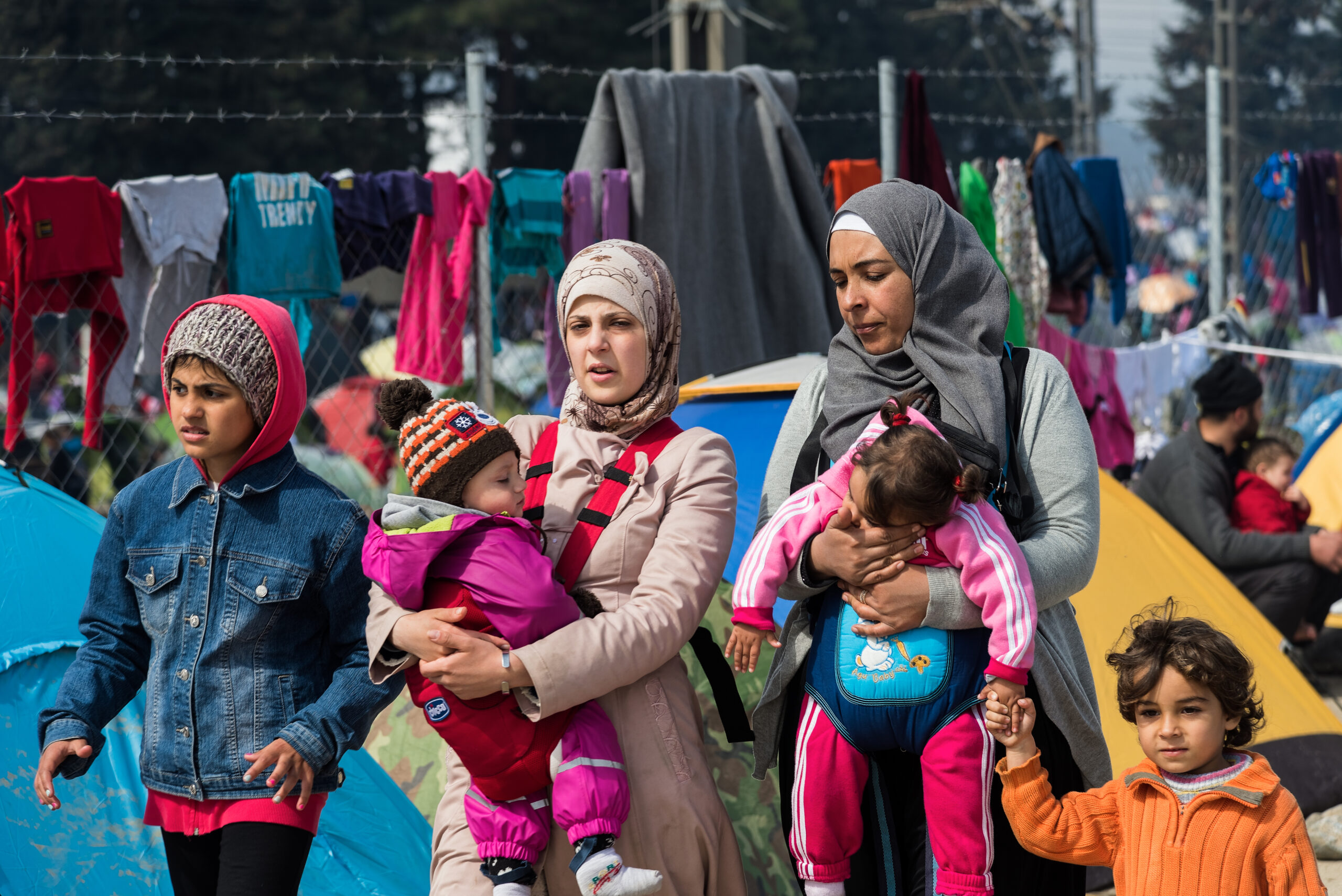

Global trends in 2022 indicated an increase in the number of forcibly displaced women and girls, who account for 51 percent of refugees, 52 percent of internally displaced people, and 51 percent of stateless individuals.[1] In the European Union (EU), 29.2 percent of first-time asylum seekers are women and girls.[2] Under the 1951 Refugee Convention, “refugees” are people who have a “well-founded fear of being persecuted for reasons of race, religion, nationality, membership of a particular social group or political opinion” and who are outside their country of origin.[3] In contrast, the convention defines an “asylum seeker” as a refugee “whose claim has not yet been finally decided on by the country in which he or she has submitted it.”[4] Asylum seekers often seek urgent protection because they suffered from persecution in their home countries; but they come to face uncertainty within European legal frameworks.
Most scholars have regarded people seeking asylum as a homogeneous group,[5] rendering invisible the specific experiences of women facing various gendered barriers that often lead to socio-economic impoverishment. Moreover, the multidimensional nature of the challenges that women and girls must surmount in the process of seeking asylum in the EU contradicts the simplistic image generally attributed to them in public discourse. Such discourse “reproduce[s] the myth that women asylum seekers are mostly dependents or ‘followers’ of men.”[6] Yet, many women and girls embark on risky journeys on their own in search of a safer place than the one they are leaving behind. Their voices, struggles, and fears are subsumed into the maze of superfluous information marginalizing their unique stories as single mothers, unaccompanied minors, or educated professionals. This invisibility undermines their resilience, creativity, and courage, as they work to overcome economic and social uncertainty. When it comes to women and girls, the fragmented character of asylum policies in European countries—coupled with a sustained lack of recognition of their specific need for protection—makes them more likely to become poor and homeless.
A fragmented legal and institutional framework for women seeking asylum in Europe
Female asylum seekers in Europe face barriers when attempting to substantiate their claims on the ground of gender-based persecution. They must navigate the complexity of bureaucratic and legal systems often without sufficient financial or legal support. It has also been shown that they lack the necessary information about their rights in their pursuit to be taken seriously.[7] Under the 1951 Refugee Convention, gender is not explicitly codified as an eligible ground for international protection.[8] EU institutions have acknowledged that “women and girls seeking asylum have specific protection needs and different concerns from men” and urged that the asylum process “be gender sensitive.”[9] However, the interpretation and application of the principles included in the Refugee Convention have been left to the individual member states, often to the detriment of women who are applying for asylum on gender-based grounds.[10] These women may have been subjected to various gender-specific persecutions in their home countries, such as honor crimes, trafficking, sexual violence, and forced marriages.[11]
While female asylum seekers may have had diverse and traumatic experiences, the common thread underlying their stories is often loss and violence.[12] However, such persecutions are not uniformly recognized among EU member states as valid grounds for international protection. Notably, some EU countries have made blanket exceptions for country-specific circumstances,[13] but gender-based claims have generally been subjected to rigid credibility assessment procedures,[14] and different EU member states have recognized these claims differently.[15] Some scholars have argued that even the European Court of Human Rights deviates from equal protection provisions in the case of female asylum seekers “every time it under-scrutinizes the gendered roots of the risk of ill-treatment and over-scrutinizes the individual capacity to deal with the risk.”[16] While some intergovernmental organizations have viewed gender-based violence as a “global pandemic” that impacts one in three women in their lifetime,[17] others have relied on lax interpretations by individual decision-makers, who are sometimes indifferent to the invisible suffering of asylum-seeking women.[18] The proportion of asylum-seeking women experiencing gender-based violence in their countries of origin is fairly high; but according to Elle and Kothen (2021) and based on data from Germany, “refugee protection on the grounds of gender-specific persecution was ultimately granted in only between 1% and 6% of cases in recent years.”[19] Such impediments are entrenched within the political and economic processes of European institutions. They ultimately make asylum-seeking women vulnerable to exploitation, destitution, and social isolation and expose them to the risk of poverty, homelessness, illness, and even death.[20]
There are significant variations across EU member states in how women’s general needs are addressed during the asylum application process and the credibility assessment procedure. The 2015 Women-Friendliness in Asylum Index[21] conveys differences in the way EU member states address gender in asylum policies. Based on the analysis of various indicators, the index score ranges from 0 (lowest score) to 1 (highest score). Tellingly, in countries that scored high on the Index, many women serve in the government.[22] In 2015, Sweden scored a 0.9, followed by Spain (above 0.8) and Belgium (above 0.7), whereas other countries such as Greece, Bulgaria, Croatia, Cyprus, Hungary, and Lithuania received the lowest scores, with values below 0.4. Central and Eastern European countries generally performed below the Index’s average. As a result, some EU member states have started developing and including specific gender-sensitive provisions in their asylum policies. For example, since December 2022 Finland and Sweden have recognized that the situation in Afghanistan qualifies all Afghan women and girls for international protection on the basis of gender.[23] According to the Finnish Immigration Service, all Afghan women are considered “categorically subject to persecution in Afghanistan,” and for them asylum requirements on the ground of gender alone are deemed to be automatically met.[24] Denmark followed suit in February 2023 with the same level of protection for Afghan women and girls, which also meant reopening requests that had been rejected between August 2021 and February 2023.[25]
Accommodation and healthcare challenges among asylum-seeking women in Europe
The Council of Europe has reported that women and girls are also vulnerable to gender-based violence within reception centers in Europe.[26] The situation among women asylum seekers on the islands of Lesvos, Chios, and Samos in Greece has exemplified the security and socio-economic anguish they face. It is common in overcrowded camps that unsanitary conditions, inadequate medical and social assistance, and precarious accommodations, expose women asylum seekers to unsafe conditions.[27] According to a news report published in 2020 about women refugees, “new arrivals are making their own shelters out of wooden pallets and tarpaulin, and digging their own toilets;” moreover, it is estimated that 28 percent of female asylum seekers have experienced sexual and gender-based violence after their arrival to these asylum camps. They often try not to leave their tents and use central latrines for fear of being harassed or even attacked. [28]
Despite the paucity of research on the experiences of female asylum seekers, some evidence has revealed that they encounter tremendous difficulties in seeking refuge and establishing a sense of normalcy, which for many of them comes at a high cost. Asylum policies have been shown to be gender-biased, to ignore women’s particular needs,[29] and to foster a “culture of silence”[30] that perpetuates vulnerabilities. Some NGOs have assessed that women often face conditions so grave in Europe that “the situation for them is even less safe than the conflicts they fled.”[31] In “hotspot” reception countries, major shortages in the provision of basic social and medical services have emerged, as these places are generally under-equipped to properly care for female asylum seekers and address their safety needs. In other countries, asylum-seeking women also face lengthy stays in reception and accommodation centers where they are isolated and prevented from participating in activities that would enhance their mental and physical well-being. A study on female asylum seekers in the Netherlands concluded that “they live in small rooms in poverty, are regularly moved from one place to another to prevent them from settling and fail to have meaningful daily activities.”[32] In addition, asylum-seeking women generally have limited access to services for trauma-related counseling and have to wait for them; moreover, other health concerns may go completely unaddressed because of language barriers and a lack of interpreters.[33] An official at a Refugee Council in Saxony-Anhalt (eastern Germany) stated that “many women remain invisible, [and] services do not reach them.”[34] This limited accessibility to adequate mental and physical care has pushed asylum-seeking women into sub-optimal living conditions and have prolonged their state of impoverishment.
It has also been shown that pregnant women seeking asylum in the Netherlands are more inclined to suffer from poor physical and mental health than pregnant women in the general population. For example, maternal morbidity in the Netherlands is 4.5 times higher among asylum-seeking women than among the general population and 3.6 higher than among the population of immigrants who hold permanent residency.[35] Likewise, research in the UK has indicated that maternal mortality among asylum seekers and refugees during childbirth is three times more that of the general population. These women are also up to four times more likely to suffer from postnatal depression.[36] A meta-ethnography of maternal experiences among asylum-seeking women has revealed that they are “just having to survive” and feel isolation and despair.[37] Some scholars have gone so far as to label asylum systems as “hostile environments” for asylum-seeking mothers.[38]
Destitution and poverty among asylum-seeking women in Europe
Women asylum seekers may become destitute at any point during their asylum journey, and this poverty may be intermittent or recurrent. According to Women for Refugee Women—an NGO based in London that conducted research on destitute, female asylum seekers in England and Wales in 2020—a destitute person is defined as having “no statutory support or housing, and no right to work.” [39] A report[40] produced by this NGO in 2020 states that 46 percent of the surveyed women asylum seekers became cyclically destitute while applying for asylum. Destitution may be caused by delayed government support. Sometimes, women do not apply for benefits for fear that their asylum claims may be impacted or simply because they are unaware of the benefits to which they are entitled.[41] In addition, asylum applications can be complex, leading to drawn out decisions and uncertain immigration status, making it difficult for all asylum seekers to work or apply for different levels of support. Some women have reported that it took ten years for them to receive a final decision on their application. The report reveals that 29 percent of women asylum seekers had become destitute in 2020 as a result of months-long delays in support and that 27 percent had not applied for any support within the first month of their asylum application.[42]
Even when successful in their claims, women asylum seekers may still be at risk of falling into poverty because benefits they are entitled to may take a long time to be disbursed. For example, a woman from Somalia who was granted asylum in December 2018 in the UK started receiving benefits only nine months later, in September 2019. She explained that “being destitute after getting asylum isn’t something I had expected,” echoing the fears and concerns of many other female asylum seekers.[43] In the UK, the “move-on” time frame was instituted, by which successful asylum applicants have only 28 days to meet the necessary stipulations of self-sufficiency before any asylum support is removed. These stipulations include opening a bank account, becoming employed, applying for other benefits available to the general population, and finding living accommodations.[44] For those women who see their asylum claims denied in England and Wales, a 2020 survey revealed that 75 percent of them became destitute.[45] Particularly telling is the case of Mercy Baguma, a woman from Uganda who sought asylum in Glasgow (UK) and ended up living in extreme poverty after she lost her job because her immigration status had expired. It was reported that she relied on donations for food and died in utter poverty leaving behind a one-year-old malnourished son.[46] Her case brought attention to the significant hardships women face while applying for asylum.
The Women for Refugee Women report and the story of Mercy Baguma reveal a grim picture of destitution among women asylum seekers whose dreams of building a stable and prosperous life in Europe are crushed as they must fight for bare survival. It is estimated that in 2020, 95 percent of destitute female asylum seekers in England and Wales were hungry, 87 percent relied on charities for food, and 25 percent begged for food on the streets.[47] Destitute female asylum seekers face food insecurity and inadequate shelters every day. While these statistics are based on a limited sample and specific local contexts, they account for the general challenges that female asylum seekers continue to face in the absence of concrete support mechanisms. Moreover, their plight has remained invisible because of insufficient data and underreporting.[48]
Labor market access challenges for all asylum-seekers
Recently, living costs across Europe have risen, further impacting asylum-seeking women’s ability to secure adequate standards of living. Additionally, they face labor market restrictions. For example, the UK has one of the more restrictive labor policies in Europe. There, asylum seekers—whether men or women—must wait twelve months to apply for a work permit and they may only access jobs on the “shortage occupation list.”[49] In contrast, in Belgium, asylum seekers must wait four months from their date of arrival and are not restricted; but even there, access to the labor market is not without major impediments in practice. Challenges come in many forms. Foreign diplomas may not be recognized or there might be blatant discrimination.[50] As a result, all asylum seekers have limited economic opportunities and remain dependent on government support, which is often insufficient. Thus, women (and men) asylum seekers face scarce economic opportunities and inadequate financial assistance,[51] which make them economically deprived and exacerbate the risk that they could be exploited and isolated socioeconomically.
The necessity for comparative research on asylum-seeking women
Even when policies and legislation take into account women’s need for protection, such measures “may not actually address some of the important insecurities facing these women.”[52] While there have been some efforts across the EU to remedy such inequities,[53] much remains to be done to afford women and girls the needed protection. Poverty and homelessness among asylum-seeking women in Europe necessitate longitudinal, comparative, and interdisciplinary research. Such research would further shed light onto the lived experiences of asylum-seeking women and girls across Europe. It would generate knowledge about the grave disparities in asylum proceedings that affect women and girls both in the short-term and the long-term across different socioeconomic contexts. At the same time, future comparative research must unpack the innovative ways in which women have dismantled dominant narratives that portray them as passive actors and the ways in which they have adopted specific mechanisms to cope with poverty and homelessness. Such research could help us shape a productive academic and policy-relevant discourse in this field and by the same token empower policy-makers to challenge asylum mechanisms and legal frameworks that marginalize female asylum seekers.
Vanja Petricevic is Associate Professor in Political Science at Florida Gulf Coast University.
[1] UNHCR, Global Trends – Forced Displacement in 2022. https://www.unhcr.org/global-trends-report-2022
[2] Eurostat, Annual asylum statistics 2023. https://ec.europa.eu/eurostat/statistics-explained/index.php?oldid=378032#Age_and_sex_of_first-time_applicants
[3] UNHCR, “The 1951 Refugee Convention,” https://www.unhcr.org/about-unhcr/who-we-are/1951-refugee-convention
[4] IOM, Glossary on Migration. 2019.
[5] Laura Shobiye and Samuel Parker, “Narratives of coercive precarity experienced by mothers seeking asylum in the UK (Wales),” Ethnic and Racial Studies 46, no. 2 (2023): 358-377.
[6] Maggie O’Neill, Asylum, Migration and Community (Bristol: Policy Press, 2010),” 206.
[7] Women’s Refugee Commission “Falling Through the Cracks: Refugee Women and Girls in Germany and Sweden,” March 2016, 12.
[8] UN Women, “Infographics: Women and Girl Asylum Seekers in the European Union,” June 28 2017, https://eca.unwomen.org/en/digital-library/multimedia/2017/07/infographics-women-and-girl-asylum-seekers-in-the-eu
[9] European Parliament, “Report on the situation of women refugees and asylum seekers in the EU (2015/2325(INI)),” Committee on Women’s Rights and Gender Equality, 2016, 5.
[10] UN Women, “Report on the Legal Rights of Women and Girl Asylum Seekers in the European Union,” March 2017.
[11] UN Women, “Infographics: Women and Girl Asylum Seekers in the European Union.”
[12] European Parliament, “The traumas endured by refugee women and their consequences for integration and participation in the EU host country,” Policy Department for Citizens’ Rights and Constitutional Affairs Directorate-General for Internal Policies, PE 691.875– April 2021.
[13] Anita Orav and Nefeli Barlaoura, “Refugee status for all female Afghan asylum-seekers,” European Parliamentary Research Service, PE 747.913 – May 2023.
[14] UN Women, “Report on the Legal Rights of Women and Girl Asylum Seekers in the European Union.” March 2017.
[15] European Commission, “Statistics on migration to Europe,” https://commission.europa.eu/strategy-and-policy/priorities-2019-2024/promoting-our-european-way-life/statistics-migration-europe_en
[16] Lourdes Peroni, “The Protection of Women Asylum Seekers under the European Convention on Human Rights: Unearthing the Gendered Roots of Harm,” Human Rights Law Review 18, no. 2 (2018): 348.
[17] World Bank, “Gender-Based Violence (Violence Against Women and Girls),” September 25, 2019 https://www.worldbank.org/en/topic/socialsustainability/brief/violence-against-women-and-girls
[18] For further information, see UN Women “UN Women report recommends recognition of gender-based violence as a basis for asylum,” May 3, 2017.
[19] Johanna Elle and Andrea Kothen. “The Implementation of the Istanbul Convention in Relation to the Refugee Women and Girls in Germany,” PRO ASYL, July 2021, 26.
[20] See Nehalennia Van Hanegem, Andrea S. Miltenburg, Joost J. Zwart, Kitty W.M. Bloemenkamp and Jos Van Roosmalen, “Severe acute maternal morbidity in asylum seekers: a two-year nationwide cohort study in the Netherlands,” Acta Obstetricia et Gynecologica Scandinavica 90, no. 9 (2011):1010-1016; Sonia Asif, Amy Baugh and Nia Wyn Jones. “The obstetric care of asylum seekers and refugee women in the UK.” The Obstetrician & Gynaecologist 17, no. 4 (2015): 223-231; Priscilla Dudhia, “Will I ever be safe? Asylum-seeking women made destitute in the UK,” Women for Refugee Women, February 2020; Claudia Webbe, “Mercy Baguma’s tragic death should mark a turning point for the Home Office,” The Guardian, August 26, 2020, https://www.theguardian.com/commentisfree/2020/aug/26/mercy-beguma-death-home-office-asylum-seeker
[21] Patrick Emmenegger and Katarina Stigwall, “Women-Friendliness in European Asylum Policies: The Role of Women’s Political Representation and Opposition to Non-EU Immigration,” Comparative Political Studies 52, no. 9 (2019): 1293–1327.
[22] Ibid.
[23] Orav and Barlaoura, “Refugee status for all female Afghan asylum-seekers.”
[24] Finnish Immigration Service, “Refugee status to all Afghan women and girls,” February 15, 2023. https://migri.fi/en/-/refugee-status-to-afghan-women-and-girls
[25] Orav and Barlaoura, “Refugee status for all female Afghan asylum-seekers.”
[26] Council of Europe, “Migrant and Refugee Women and Girls,” https://coe.int/en/web/genderequality/migrant-and-refugee-women-and-girls#{%2263602265%22:[0]}
[27] Devon Cone, “Seeking Asylum in Greece: Women and Unaccompanied Children Struggle to Survive,” Refugees International, February 27, 2020, https://www.refugeesinternational.org/reports-briefs/seeking-asylum-in-greece-women-and-unaccompanied-children-struggle-to-survive/
[28] Louise Hunt, “Greek migrant camps endanger women and girls, says new report.” The New Humanitarian, February 28, 2020, https://www.thenewhumanitarian.org/news/2020/02/28/Greek-migrant-camps-SGBV-women-girls
[29] O’Neill, Asylum, Migration and Community.
[30] European Parliament, “The traumas endured by refugee women and their consequences for integration and participation in the EU host country.”
[31] Cone, “Seeking Asylum in Greece.”
[32] Nehalennia Van Hanegem, Andrea S. Miltenburg, Joost J. Zwart, Kitty W.M. Bloemenkamp and Jos Van Roosmalen, “Severe acute maternal morbidity in asylum seekers: a two-year nationwide cohort study in the Netherlands,” Acta Obstetricia et Gynecologica Scandinavica 90, no. 9 (2011):1010.
[33] Elle and Kothen, “The Implementation of the Istanbul Convention in Relation to the Refugee Women and Girls”
[34] Ibid., 40.
[35] Van Hanegem et al., “Severe acute maternal morbidity in asylum seekers.”
[36] Sonia Asif, Amy Baugh and Nia Wyn Jones. “The obstetric care of asylum seekers and refugee women in the UK.” The Obstetrician & Gynaecologist 17, no. 4 (2015): 223-231.
[37] Glenys D. Frank, Deborah Fox, Carolyne Njue and Angela Dawson, “The maternity experiences of women seeking asylum in high-income countries: a meta-ethnography,” Women and Birth 34, no. 6 (2021): 531.
[38] Shobiye and Parker, “Narratives of coercive precarity.”
[39] Priscilla Dudhia, “Will I ever be safe? Asylum-seeking women made destitute in the UK,” Women for Refugee Women, February 2020,11.
[40] The report surveyed 106 (in total) destitute female asylum seekers in England and Wales.
[41] Dudhia, “Will I ever be safe?”
[42] Ibid.
[43] Ibid., 9.
[44] British Red Cross, “Still an Ordeal – The Move-On Period for New Refugees,” Policy, Research and Advocacy, 2018.
[45] Dudhia, “Will I ever be safe?”
[46] Claudia Webbe, “Mercy Baguma’s tragic death should mark a turning point for the Home Office,” The Guardian, August 26, 2020, https://www.theguardian.com/commentisfree/2020/aug/26/mercy-beguma-death-home-office-asylum-seeker
[47] Dudhia, “Will I ever be safe?”
[48] Ibid.
[49] Melanie Gower, CJ McKinney and Lulu Meade, “Asylum seekers: the permission to work policy,” Research Briefing, House of Commons Library, December 9, 2022, https://commonslibrary.parliament.uk/research-briefings/sn01908/
[50] European Council on Refugees and Exiles, Asylum Information Database, “Access to the Labour Market – Belgium” https://asylumineurope.org/reports/country/belgium/reception-conditions/employment-and-education/access-labour-market/
[51] European Council on Refugees and Exiles, Asylum Information Database, “Forms and Levels of Material Reception Conditions – Sweden,” https://asylumineurope.org/reports/country/sweden/reception-conditions/access-and-forms-reception-conditions/forms-and-levels-material-reception-conditions/; European Council on Refugees and Exiles, Asylum Information Database, “Forms and Levels of Material Reception Conditions – Netherlands” https://asylumineurope.org/reports/country/netherlands/reception-conditions/access-and-forms-reception-conditions/forms-and-levels-material-reception-conditions/
[52] Jane Freeman. “Protecting Women Asylum Seekers and Refugees: From International Norms to National Protection?” International Migration 48, no. 1 (2010), 176.
[53] European Union Agency for Asylum. “Protecting women and girls in the asylum procedure,” Fact sheet EUAA/IAS/2022/11, August 2022.
Published on November 21, 2023.




